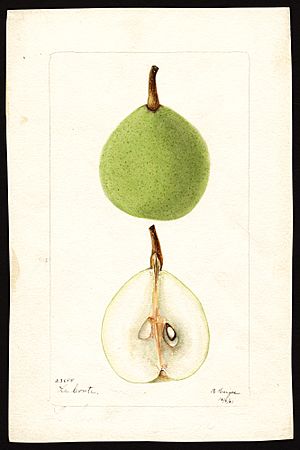Le Conte pear facts for kids
Quick facts for kids Le Conte pear |
|
|---|---|

Fruit of the Le Conte pear
|
|
| Hybrid parentage | Pyrus hybrid P. x lecontei P. communis x P. pyrifolia |
| Cultivar | 'Le Conte' |
| Origin | Georgia, 1856 (Rehder) |
The Le Conte pear is a special type of pear tree known for its tasty fruit. It's a deciduous tree, which means it loses its leaves in the fall, just like many trees you see around. This pear was first introduced in Georgia in 1856 and is named after a famous person who helped bring it there.
Contents
About the Le Conte Pear Tree
The Le Conte pear tree can grow quite tall, reaching up to 8 meters (about 26 feet) high. It's a strong tree that isn't easily damaged by cold weather or frost. This makes it a good choice for growing in many different places.
Flowers and Pollination
The flowers of the Le Conte pear tree are quite interesting. They are hermaphrodite, which means each flower has both male and female parts. This allows them to produce fruit. Tiny insects, like bees, help to pollinate these flowers. Pollination is when pollen is moved from one part of a flower to another, or from one flower to another, which helps the plant make seeds and fruit.
The Delicious Le Conte Pear Fruit
The fruit of the Le Conte pear is very popular because it's so versatile. You can eat it fresh, right after it's picked from the tree. It also tastes great when cooked.
Fruit Characteristics
Le Conte pears are usually about 8 centimeters (around 3 inches) long and 5 centimeters (about 2 inches) wide. The inside of the fruit, called the flesh, is similar to that of an Asian pear. This means it's often crisp and juicy.
How to Enjoy Le Conte Pears
These pears are perfect for snacking on raw. They can also be stored for a long time, from a few days up to several months, if kept properly. Many people love to use Le Conte pears in cooking. They are often baked into delicious pies or made into sweet preserves, like jams and jellies.
History and Naming
The Le Conte pear is named after John Eatton Le Conte. He was the person who brought this particular type of pear to Georgia in the year 1856. His work helped make this tasty pear known and grown in the United States.


